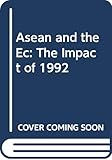ASEAN and the EC : The Impact of 1992 / Nobert Wagner.
Material type: TextPublisher: Singapore : ISEAS Publishing, [1992]Copyright date: ©1992Description: 1 online resource (280 p.)Content type:
TextPublisher: Singapore : ISEAS Publishing, [1992]Copyright date: ©1992Description: 1 online resource (280 p.)Content type: - 9789813035706
- 9789814377003
- online - DeGruyter
- Issued also in print.
| Item type | Current library | Call number | URL | Status | Notes | Barcode | |
|---|---|---|---|---|---|---|---|
 eBook
eBook
|
Biblioteca "Angelicum" Pont. Univ. S.Tommaso d'Aquino Nuvola online | online - DeGruyter (Browse shelf(Opens below)) | Online access | Not for loan (Accesso limitato) | Accesso per gli utenti autorizzati / Access for authorized users | (dgr)9789814377003 |
Frontmatter -- Contents -- List of Tables -- List of Figures -- Acknowledgements -- Part I: Introduction -- I. The EC Internal Market and ASEAN: An Overview -- Part II. Completing the EC Internal Market -- II. Completing the EC Internal Market: An Update and Problems Ahead -- III. The EC Internal Market Programme: Implications for External Trade -- IV. The EC Internal Market: Implications for Capital Flows -- Part III. Implications for ASEAN -- V. An Analysis of ASEAN-EC Trade in Textiles and Electronics, 1980-88 -- VI. The EC Internal Market and the ASEAN Electronics Industry -- VII. The EC Internal Market and the ASEAN Textile and Clothing Industry -- VIII. The Harmonization of Technical Standards and Regulations in the EC: Implications for ASEAN -- IX. The EC Internal Market and ASEAN-EC Trade in Services -- X. The EC Internal Market and ASEAN-EC Direct Investment Flows -- XI. The European Currency System and ASEAN -- Contributors
restricted access online access with authorization star
http://purl.org/coar/access_right/c_16ec
European economic integration has gathered new momentum since Member States of the European Community (EC) signed the Single European Act in February 1986 aimed at creating a region with no internal frontiers and with free movement of goods and services, capital, labour and the professions by the end of the year 1992. Since then, numerous decisions have been made by EC heads of governments , the EC Council of Members, the EC Commission, the European Parliament and the twelve national parliaments in order to achieve this ambitious goal. As third world countries are increasingly becoming more aware of the emerging internal EC market, they are increasingly concerned about the implications and repercussions of this single European market on their future econoic relations with the EC and the impact on their national economies.
Issued also in print.
Mode of access: Internet via World Wide Web.
In English.
Description based on online resource; title from PDF title page (publisher's Web site, viewed 07. Jan 2021)


